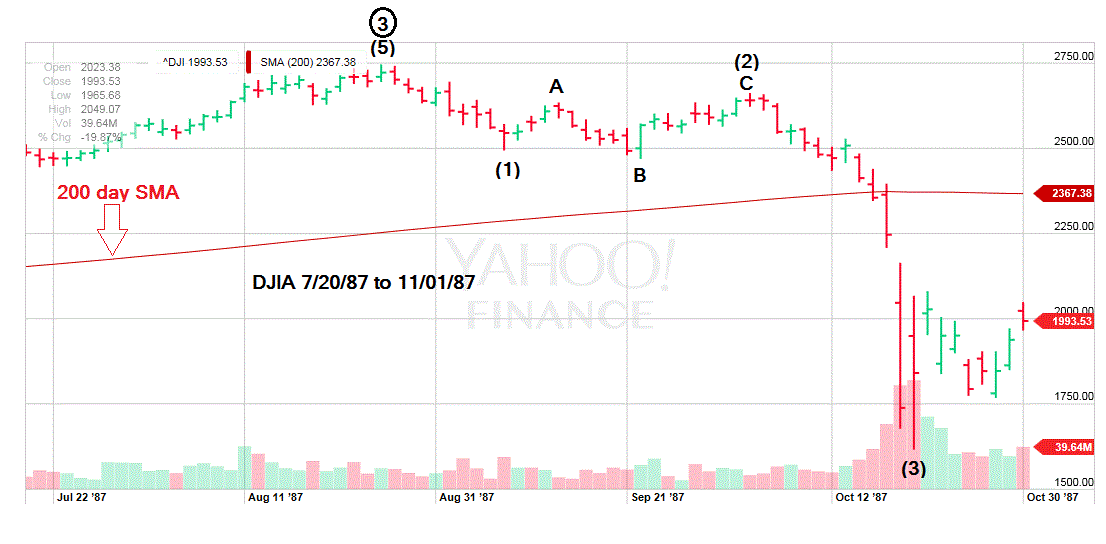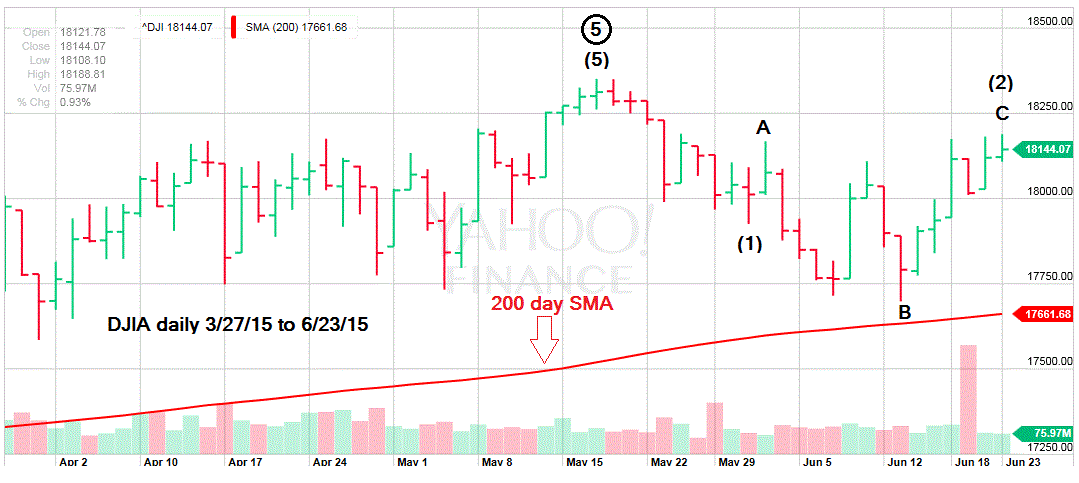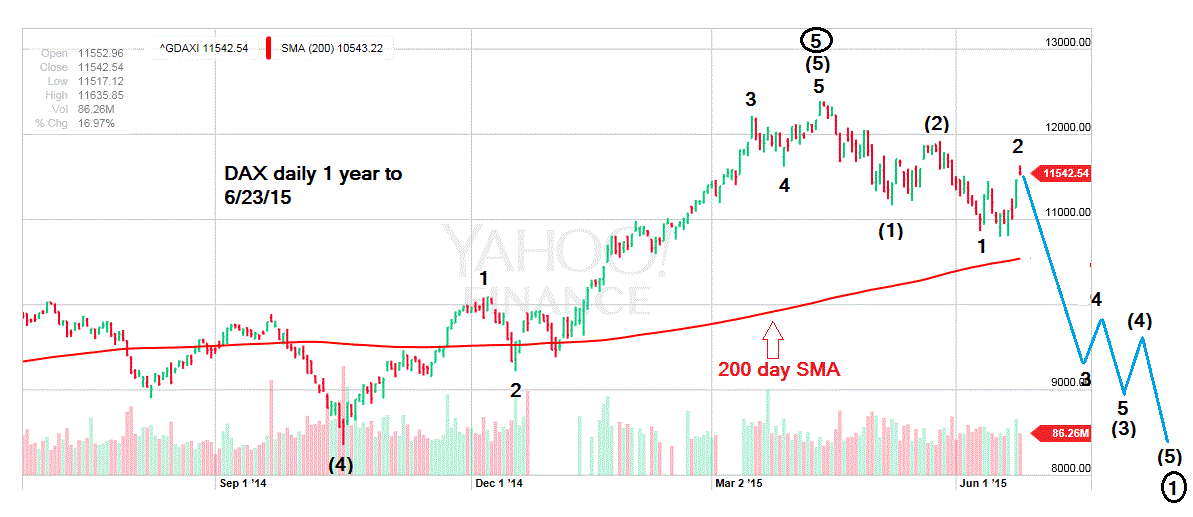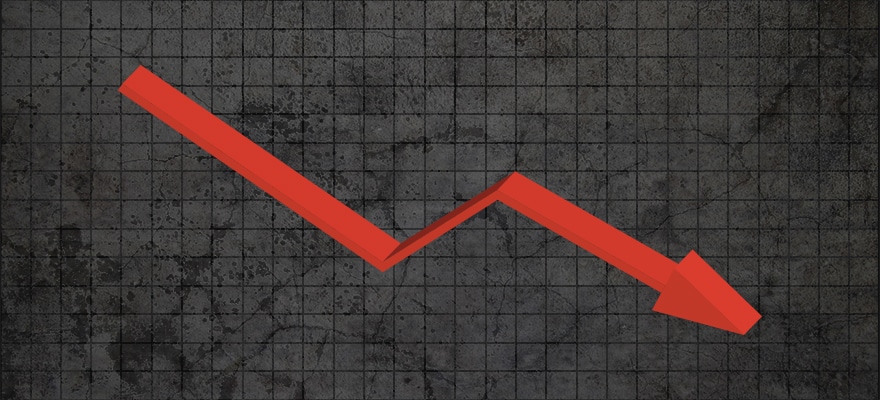
Mark Rivest
This article is written by Mark Rivest, an independent investment advisor and trader. He has written articles for Technical Analysis of Stocks and Commodities and Traders.com Advantage.
October of 1987 had one of the most spectacular crashes in the history of the stock market. The Dow Jones Industrial Average (DJIA) from its August 1987 peak declined 36% in less than two months. The drop was stunning with all major world stock indices experiencing severe declines of the same degree. In 2015, a smaller scale crash could happen late June to early July.
DJIA 1987 vs. DJIA 2015
Please see the illustrated 1987 DJIA chart in Figure 1. and the illustrated 2015 DJIA chart in Figure 2.

(Provided by Yahoo! Finance)

(Provided by Yahoo! Finance)
Both years had initial declines off their primary peaks followed by Elliott Wave “Expanding Flat” patterns. In an Expanding Flat wave “B” terminates beyond the starting point of wave “A” and wave “C” ends beyond the ending level of wave “A.”
In declining markets this corrective pattern portends a subsequent powerful move down.
In 1987, the initial decline and the subsequent Expanding Flat correction were just the setup phase for the main crash, which began after the secondary top made on October 2, 1987. The decline from DJIA primary peak made on August 25, 1987, to the Expanding Flat “B” wave low made on September 22, 1987, was 9.3%. The entire decline from August to October was 36.1%
The decline from the primary peak made on May 19, 2015, to the supposed “B” wave low on June 15, 2015, was only 3.5%, much smaller than the set up phase in 1987.
If there is a crash in 2015, it will most likely be much smaller than the 1987 panic decline. A probable stopping point for a 2015 mini crash would be the DJIA October 2014 bottom at 15,855.
By comparing the 1987 set up phase to the subsequent crash, we find a ratio that strengthens the case for a 2015 mini crash ending in the area of the October 2014 bottom. The total DJIA 1987 decline was 36.1%, the setup phase was 9.3%.
Divide 36.1 by 9.3 equals 3.88. The supposed 2015 set up phase was 3.5% or 653 DJIA points. Multiply 653 by 3.88 equals 2533 points. The DJIA primary peak of 18,351 minus 2,533 equals 15,818, very close to the October 2014 bottom of 15,855.
The 1987 set up phase from August 25 to October 2 was 38 days, the crash into October 19th was 17 days. The supposed setup phase in 2015 from May 19th to June 23rd was 35 days. The time factor is almost the same, 17 days added to June 23rd targets July 10th as a possible panic bottom. An alternate date could be July 6th, a Monday which like in 1987 was the worst day of the panic, coming off a weekend of worry.
DJIA vs. DAX
Price patterns are just one piece of the puzzle, very weak momentum in US stock indices is another reason to expect a sudden decline in the later half of June. For several months the number of stocks reaching 52-week highs have not confirmed new highs made in US stock indices, volume has been weak on many of the rallies.
Another major non conformation to the DJIA recent performance comes from the German DAX stock index.
Please see the illustrated daily chart of the DAX in Figure 3.

(Provided by Yahoo! Finance)
Most of this year the DAX has outperformed the DJIA. From the beginning of 2015 to its May high the DJIA was up 6.4%. The DAX from the beginning of 2015 to its April peak was up 26.3% .
In June the DAX is still the leader, except now it's leading the way down. On June 23rd the DJIA was down only 1.2% from its high of the year. The DAX was down 6.8% from its 2015 high.
Even more stunning, the DAX appears to be making a series of one’s and two’s down from the April peak. This is one of the most bearish Elliott wave configurations, with the 3rd of a 3rd wave being the most dynamic. The DAX could be on the verge of a near vertical decline. The center of this price pattern is referred to as “the point of recognition.”
This is where the vast majority of traders and investors recognize the trend has changed.
In stock markets this is also the point of heaviest downside volume, with decliners outpacing advancers by a wide margin.
Please note where the 200 day Simple Moving Average (SMA) is on the DAX chart. A significant breach could trigger “the point of recognition”. Also please note what happened in 1987 when the DJIA breached the 200 day SMA.
Conclusion
For several months the major US stock indices have been in a narrow trading range. During this time the bulls have become complacent while the bears have been frustrated.
The markets have a nasty habit of faking out the majority just before a big move.
The DJIA pattern from its primary peak in May to the secondary peak in June is a clue that underneath the surface, selling pressure has been building. If water flows through a rubber hose and you pinch the hose, water pressure builds up. After you release the pinch, water comes rushing out.
A decisive break below of both the DAX and DJIA 200 day SMA could release selling pressure. Be prepared to take action and go with the flow.






















